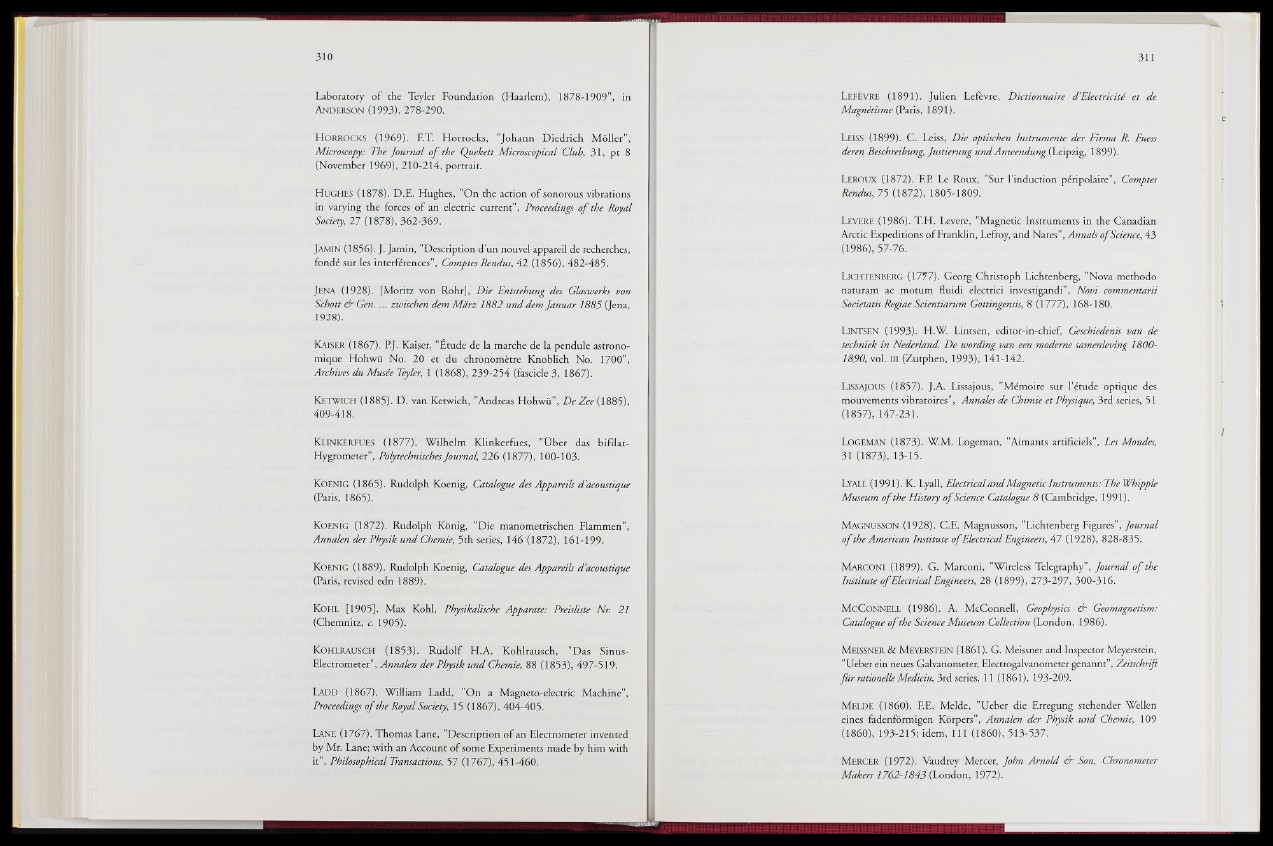
Laboratory of the Teyler Foundation (Haarlem), 1878-1909", in
Anderson (1993), 278-290.
HORROCKS (1969). F.T. Horrocks, "Johann Diedrich Möller",
Microscopy: The Journal o f the Quekett Microscopical Club, 31, pt 8
(November 1969), 210-214, portrait.
HUGHES (1878). D.E. Hughes, "On the action of sonorous vibrations
in varying the forces of an electric current", Proceedings o f the Royal
Society, 27 (1878), 362-369.
JAMIN (1836). J. Jamin, "Description d'un nouvel appareil de recherches,
fondé sur les interférences", Comptes Rendus, 42 (1856), 482-485.
JENA (1928). [Moritz von Rohr], Die Entstehung des Glaswerks von
Schott & Gen. ... zwischen dem März 1882 und dem Januar 1885 (Jena,
1928).
KAISER (1867). P.J. Kaiser, "Étude de la marche de la pendule astronomique
Hohwii No. 20 et d u chronomètre Knoblich No. 1700",
Archives du Musée Teyler, 1 (1868), 239-254 (fascicle 3, 1867).
Ke t w ioe (1885). D. van Ketwich, "Andreas Hohwü", De Zee (1885),
409-418.
Klinkerfues (1877). W ilh e lm Klinkerfues, "Üb e r das bifilar-
Hygrometer", Polytechnisches Journal, 226 (1877), 100-103.
KOENIG (1865). Rudolph Koenig, Catalogue des Appareils d'acoustique
(Paris, 1865).
KOENIG (1872). Rudolph König, "Die manometrischen Flammen",
Annalen der Physik und Chemie, 5 th series, 146 (1872), 161-199.
KOENIG (1889). Rudolph Koenig, Catalogue des Appareils d'acoustique
(Paris, revised edn 1889).
KOHL [1905ffl Max Kohl, Physikalische Apparate: Preisliste Nr. 21
(Chemnitz, c. 1905).
KOHLRAUSCH (1853). Rudolf H.A. Kohlrausch, "Das Sinus-
Electrometer", Annalen der Physik und Chemie, 88 (1853), 497-519.
Ladd (1867). William Ladd, "On a Magneto-electric Machine",
Proceedings o f the Royal Society, 15 (1867), 404-405.
LANE (1767). Thomas Lane, "Description of an Electrometer invented
by Mr. Lane; with an Account of some Experiments made by him with
it", Philosophical Transactions, 57 (1767), 451-460.
LEFÈVRE (1891). Julien Lefèvre, Dictionnaire d'Electricité et de
Magnétisme (Paris, 1891). e
Leiss (1899). C. Leiss, Die optischen Instrumente ¿1er Firma R. Fuess
deren Beschreibung, Justierung und Anwendung (Leipzig, 1899).
LEROUX (1872). F.P. Le Roux, "Sur l'induction péripolaire", Comptes
Rendus, 75 (1872), 1805-1809.
LEVERE (1986). T.H. Levere, "Magnetic Instruments in the Canadian
Arctic Expeditions of Franklin, Lefroy, and Nares", Annals o f Science, 43
(1986), 57-76.
LlCHTENBERG (1777). Georg Christoph Lichtenberg, "Nova methodo
naturam ac motum fluidi electrici investigandi", Novi commentarii
Societatis Regiae Scientiarum Gottingensis, 8 (1777), 168-180.
LlNTSEN (1993). H.W. Lintsen, editor-in-chief, Geschiedenis van de
techniek in Nederland. De wording van een moderne samenleving 1800-
1890, vol. Ill (Zutphen, 1993), 141-142.
LlSSAJOUS (1857). J.A. Lissajous, "Mémoire sur l'étude optique des
mouvements vibratoires", Annales de Chimie et Physique, 3rd series, 51
(1857), 147-231.
1
LOGEMAN (1873). W.M. Logeman, "Aimants artificiels", Les Mondes,
31 (1873), 13-15.
Lyall (1991). K. Lyall, Electrical and Magnetic Instruments: The Whipple
Museum o f the History o f Science Catalogue 8 (Cambridge, 1991).
Magnusson (1928). C.E. Magnusson, "Lichtenberg Figures", Journal
o f the American Institute o f Electrical Engineers, 47 (1928), 828-835.
MARCONI (1899). G. Marconi, "Wireless Telegraphy", Journal o f the
Institute o f Electrical Engineers, 28 (1899), 273-297, 300-316.
M cC onnell (1986). A. McConnell, Geophysics & Geomagnetism:
Catalogue o f the Science Museum Collection (London, 1986).
MEISSNER & Meyerstein (1861). G. Meissner and Inspector Meyerstein,
"Ueber ein neues Galvanometer, Electrogalvanometer genannt", Zeitschrift
Jur rationelle Medicin, 3rd series, 11 (1861), 193-209.
MELDE (1860). F.E. Melde, "Ueber die Erregung stehender Wellen
eines fadenförmigen Körpers", Annalen der Physik und Chemie, 109
(1860), 193-215; idem, 111 (1860), 513-537.
MERCER (1972). Vaudrey Mercer, John Arnold & Son, Chronometer
Makers 1762-1843 (London, 1972).